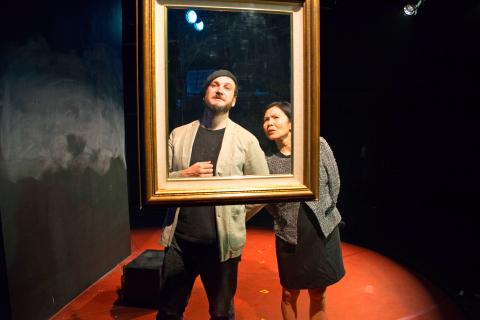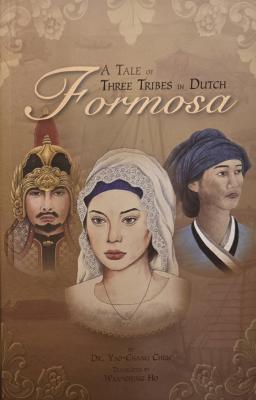LAB Space had its audience laughing up a storm last weekend with its rollicking presentation of American playwright David Ives’ Ives’ Shorts.
Diverse existentialist conundrums is the name of the game as Ives delivers six distinct “shorts” and clearly challenges actors and actresses to handle multiple roles with a variety of witty and changing dialogues. Guest directors Ting Kao (高詩婷) and Andrew Chao (周厚安) have chosen and directed their cast well and found new talent in the process.
James Lo (羅濟豪), one of many newcomers to LAB, is at his best in Words, Words, Words, the classic test to prove the “Infinite Monkey Theorem.” In Sure Thing, he had run a gamut of pick-up lines with a blossoming Carrie Mo (莫少宣) and in The Philadelphia, he enjoyed the carefree spirit of being in “Los Angeles,” as opposed to Victor Stevenson’s “funky Philadelphia.” But here as the pragmatic “Milton,” he shows how a chimp can manipulate the system to get smokes. At the same time, of course, he argues practically with the plotting Swift, Charlie Storrar, that they should just type “Hamlet” (whatever that is) and get out of there.

Photo courtesy of Cheng Yi-lee
Out for revenge on the unseen yet “observing” Dr Rossenbaum, Storrar fiendishly plots a poison-tip sword death reminiscent of Shakespeare’s Laertes to do the job.
Storrar is not done; he adroitly handles other roles. In Degas C’est Moi, he pontificates as an imaginative and whimsical Degas for a day while other cast members as typical New Yorkers condescendingly ignore him. In Variations, as the pondering, cerebral Trotsky, he seeks reprieve while his inquisitive and “sometimes dutiful,” wife Sharon Landon assists.
Not to be ignored in this ensemble is Angela Collengberg. As the more focused chimp Kafka in Words, she actually gets the play done. But her best role is when she transforms from stuttering shyness to masterful “linguist” with the coaching effervescent Stevenson in Universal Language.
The set is minimalist and a merry-go-round concept of entering and leaving provides a neat, systematic way to change sets. This is live theater at its best.

May 11 to May 18 The original Taichung Railway Station was long thought to have been completely razed. Opening on May 15, 1905, the one-story wooden structure soon outgrew its purpose and was replaced in 1917 by a grandiose, Western-style station. During construction on the third-generation station in 2017, workers discovered the service pit for the original station’s locomotive depot. A year later, a small wooden building on site was determined by historians to be the first stationmaster’s office, built around 1908. With these findings, the Taichung Railway Station Cultural Park now boasts that it has

The latest Formosa poll released at the end of last month shows confidence in President William Lai (賴清德) plunged 8.1 percent, while satisfaction with the Lai administration fared worse with a drop of 8.5 percent. Those lacking confidence in Lai jumped by 6 percent and dissatisfaction in his administration spiked up 6.7 percent. Confidence in Lai is still strong at 48.6 percent, compared to 43 percent lacking confidence — but this is his worst result overall since he took office. For the first time, dissatisfaction with his administration surpassed satisfaction, 47.3 to 47.1 percent. Though statistically a tie, for most

Six weeks before I embarked on a research mission in Kyoto, I was sitting alone at a bar counter in Melbourne. Next to me, a woman was bragging loudly to a friend: She, too, was heading to Kyoto, I quickly discerned. Except her trip was in four months. And she’d just pulled an all-nighter booking restaurant reservations. As I snooped on the conversation, I broke out in a sweat, panicking because I’d yet to secure a single table. Then I remembered: Eating well in Japan is absolutely not something to lose sleep over. It’s true that the best-known institutions book up faster

The excellent historical novel by Chen Yao-Cheng (陳耀昌) is a gripping tale of Taiwan in the 17th century, called Formosa at the time, told from the perspective of characters representing the three major ethnic groups (the “tribes” mentioned in the title): the indigenous community, the Dutch and the Chinese. Another element that makes this book stand out is the female perspective, as two of the main protagonists are Maria, the daughter of the Dutch missionary Hambroeck, and Uma, an Aboriginal woman with a strong character. The main Chinese character is Chen Ze, a man in charge of a merchant ship